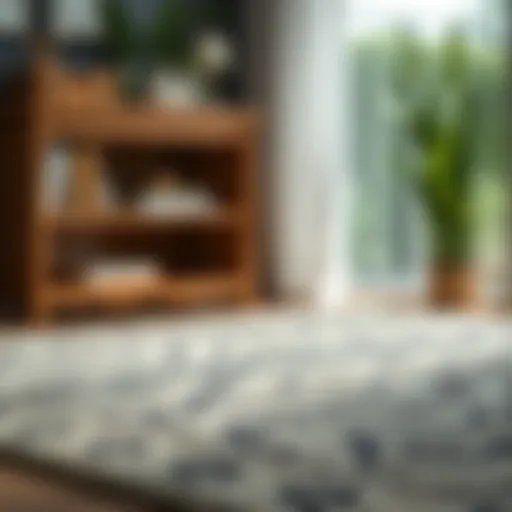Effective Strategies for a Cooler Bedroom Space


Intro
Creating a sanctuary for sleep starts with one vital element: temperature. A bedroom that feels like a sweltering sauna can quickly transform sweet dreams into restless nights. Whether it’s the furnace-like heat of summer or the sticky humidity of a tropical climate, finding ways to achieve a cooler bedroom environment is paramount. This exploration will delve deeply into strategies—some surprisingly simple—aimed at achieving that elusive comfortable atmosphere without leaning heavily on mechanical cooling systems.
In today’s fast-paced world, ensuring quality sleep not only enhances health but also boosts productivity and emotional well-being. This article will cover various tactics, from utilizing natural light and air circulation to cleverly selecting materials and décor that contribute to cooling effects. The journey includes rethinking our approach to color palettes that visually soothe and materials that breathe—each aspect playing its role in crafting a bedroom that promotes peace and rest.
Let’s set the stage by looking at some inspiring design options that not only contribute to a cooler environment but also exhibit style and comfort.
Understanding the Importance of a Cool Bedroom
Creating the ideal sleeping environment hinges significantly on temperature, especially in a space like the bedroom, where we spend a third of our lives. Understanding why keeping this area cool is crucial seems straightforward, yet many overlook a handful of pivotal elements.
Effects of Heat on Sleep Quality
Heat can be a relentless foe when it comes to a good night's rest. When temperatures soar, tossing and turning becomes an all-too-familiar dance. High heat can lead to restlessness, reducing the time spent in deep sleep—the most restorative sleep phase. According to studies, our sleep cycles are finely tuned to cooler conditions. For instance, the body's core temperature naturally dips as we fall asleep, prompting various physiological and hormonal changes essential for quality sleep.
Just picture it: a stifling room with no air circulation. You're likely to wake up multiple times, irritated by sweat-soaked sheets or the constant need to adjust the covers. This shaking of the wake-sleep cycle can accumulate, leading to chronic fatigue, lack of concentration, and irritability during daylight hours.
It's crucial to keep in mind that even subtle fluctuations in temperature can significantly affect how rested we feel upon waking.
Physiological Benefits of a Cooler Room
A cooler bedroom environment profoundly affects physiological processes. When the temperature is optimal, typically around 60 to 67 degrees Fahrenheit, the body can drop its core temperature effectively, signalling it to prepare for sleep. This drop is vital for a good night's rest and helps in numerous bodily functions, including hormone regulation.
Several key benefits arise from maintaining a cooler room:
- Enhanced Melatonin Production: A cool atmosphere encourages the production of melatonin, a hormone that regulates sleep-wake cycles.
- Reduced Heart Rate: Cooler temperatures can lower your heart rate, making it easier for the body to enter the deeper phases of sleep.
- Lower Stress Levels: Cooler environments can help in reducing levels of cortisol, the stress hormone, thus improving emotional well-being.
Furthermore, cooler temperatures can decrease the likelihood of sleep disorders, such as insomnia or sleep apnea, by promoting steady airflow and consistent oxygen levels throughout the night. In short, achieving that cooler climate not only maximizes comfort but is a cornerstone of our overall health and psychological well-being.
Assessing Your Current Bedroom Conditions
Before diving into solutions, it's crucial to take stock of your current sleeping environment. The way our bedrooms are set up can make or break our ability to get restorative sleep, and a thorough assessment serves as the foundation for improvement. Knowing the existing temperature and humidity levels allows you to fine-tune cooling strategies effectively. After all, understanding your specific circumstances is the first step toward crafting a more inviting atmosphere.
Measuring Room Temperature and Humidity
One of the simplest places to start is by evaluating your room's temperature and humidity. Grab a reliable thermometer and hygrometer to get an accurate reading. Ideal sleep conditions typically hover around 60 to 67 degrees Fahrenheit along with a humidity level of 40 to 60 percent. Knowing where you stand gives you a baseline—from which you can either celebrate your already comfy conditions or roll up your sleeves for some adjustments.
- Advantages of Monitoring:
- You can identify whether additional cooling techniques are necessary.
- Charts and logs reveal patterns, especially when combined with sleep diaries.
Using both physical measurements and personal experiences, you can correlate how temperature affects your sleep. If you notice you wake up sweating or too chilly, it might be time for some changes.
Identifying Potential Heat Sources
Next, let's turn our attention to any lurking heat sources in your bedroom. Sometimes, the sunbeam pouring through your window or that vintage lamp you adore could also be inviting extra warmth into your sleeping space. Here are some common culprits to consider:
- Appliances: Electronics generate heat—your computer, television, or even that phone charger left plugged in.
- Bedding and Decor: Dark curtains or heavy comforters can trap heat, while light-colored and breathable fabrics repel warmth.
- Inadequate Insulation: Drafty windows and walls can either accumulate heat or allow it to escape, both of which can mess with your comfort levels.
By being proactive and assessing these elements, you'll be better positioned to act on them. Conduct an informal audit of your bedroom; if something’s making you sweat more than the summer sun, it may need a rethink. After all, building a cool sanctuary begins with clarity about your current situation.
Optimizing Your Window Treatments
Optimizing your window treatments is a keystone in the quest for a cooler bedroom. The sun can be relentless, pushing heat into your space during the day, which often lingers into the night. By strategically selecting and utilizing various window coverings, you can significantly reduce the heat that enters your home and maintain a comfortable atmosphere for sleeping.
Whether it’s thick curtains, blinds, or reflective films, each option serves a unique purpose in insulating your bedroom from the sun's heat while also providing an aesthetic touch to your decor. More than just aesthetics, these treatments act as barriers against unwanted temperature increases, transforming your room into a serene sleeping sanctuary.
Choosing the Right Curtains or Blinds
When it comes to curtains and blinds, the choice can greatly influence your bedroom’s climate. Darker, heavier fabrics tend to absorb heat, but they also block more sunlight. Conversely, light-colored and sheer options, while creating a bright room, can let heat seep through. It is advisable to consider materials like blackout curtains that, apart from blocking light, can enhance thermal insulation.
Here are a few advantages of selecting suitable curtains or blinds:
- Light Control: Adjustable blinds allow you to control the degree of light entering your room.
- Thermal Insulation: Certain materials can trap air, providing insulation against heat.
- Aesthetic Appeal: Stylish options can complement your room’s design while serving functional purposes.
In your decision-making, keep in mind the placement of your windows and the direction they face. For south-facing windows, a heavier curtain can work wonders, but an eastern-facing window may benefit more from light and airy fabrics that can let in morning light without overheating.


Utilizing Reflective Films
Using reflective films is another clever way to keep your bedroom cooler without compromising on natural light. Applying these films to your windows can reflect a significant portion of the incoming sunlight, lowering indoor temperatures. They work by blocking both UV rays and radiant heat, leading to a noticeable drop in the temperature of your room. Reflective films are often a more economical alternative to replacing windows, providing long-term benefits without a hefty price tag.
"Reflective window films can block up to 78% of inbound solar heat, making them an excellent investment in maintaining a cooler home environment."
Some benefits of installing reflective films include:
- Energy Savings: By reducing the need for air conditioning, your utility bill can see a drop.
- UV Protection: These films protect your skin and furniture from harmful UV rays.
- Privacy: Many films offer a degree of privacy during the day while still allowing natural light inside.
Implementing Smart Window Coverings
Smart home technology has extended its reach into window treatments as well. Implementing smart window coverings allows for automated adjustments based on the time of day or the room’s temperature. These intelligent systems can close during peak sun hours and open to take advantage of cooler evening breezes.
Considerations for smart window coverings include:
- Integration: Many systems can integrate with existing home automation setups.
- Remote Control: Adjustments can be made via smartphone apps, providing maximum convenience.
- Customization: Some systems offer customizable settings based on your specific needs.
Investing in smart window coverings can yield both comfort and efficiency, creating a bedroom environment that adapts in real-time to changing temperature conditions.
In summary, optimizing window treatments is a vital step in achieving a cooler bedroom environment. This practice not only enhances comfort but also contributes to a more energy-efficient home, creating a sleeping space that supports rest and rejuvenation.
Ventilation Techniques to Enhance Airflow
Having a cool bedroom is not just about technology and gadgets. It also involves understanding and applying ventilation techniques that facilitate airflow. Effective ventilation can significantly impact how cool a room feels. When air circulates freely, it helps distribute cooler air and reduce stagnant heat, making it easier for you to achieve that ideal sleeping environment. Plus, good airflow doesn’t just promote comfort; it can assist with air quality, preventing moisture build-up and musty odors from creeping in.
Cross-Ventilation Strategies
Cross-ventilation — that’s a fancy term for letting fresh air pour in through one window while it flows out through a different one. Here’s the deal: when the temperature outside is lower than inside, opening windows opposite each other can create a natural breeze through your space. This can be especially useful in the early morning or late evening when temperatures dip. Positioning windows at opposite ends of the room maximizes this effect, working like a well-tuned orchestra of cozy air currents.
- Timing is Key: Open your windows during the cooler parts of the day or night.
- Pair Up with Fans: Sometimes, to kick things up a notch, you may want to pair this strategy with fans. Interesting a wind-chill effect can help make the air feel cooler than it actually is.
- Cleaning Can’t Be Overlooked: Ensure there’s no debris or overgrown plants blocking your windows — they can mess with that sweet airflow.
Using Fans for Optimal Air Circulation
Fans play a key role in air circulation, especially on sweltering nights. But, they’re not just for blowing air around haphazardly. The positioning of such devices can make all the difference. A well-placed fan can help lift warm air away from your sleeping area and push cooler air down toward you.
- Ceiling Fans: Set them to rotate counterclockwise in warm months. This disposes warm air that can accumulate near the ceiling and siphons cool air downwards.
- Floor Fans: Place them near a window to draw in that sweet, cool air. Alternatively, set one across from another to create a cross-breeze effect.
The right fan strategies can significantly lower perceived air temperature, even if the thermostat doesn't budge.
Positioning Exhaust Fans Effectively
Exhaust fans, often found in kitchens or bathrooms, can be instrumental in maintaining a cool bedroom as well, when used wisely. Their primary function is to remove stale air and moisture, but they can also help expel heat when placed correctly. Placing one near a window to pull hot air out or in a hallway to create a more open airflow can help lower the temperature in the room.
Some considerations include:
- Strategic Location: Installing an exhaust fan in a location where hot air tends to accumulate can help maintain a steady airflow.
- Timed Usage: Running the exhaust fan during peak heat hours of the day can help get rid of that heat before it settles in for the night.
- Regular Maintenance: Like any appliance, keep your exhaust fans clean and well-maintained to ensure they operate efficiently.
Incorporating these ventilation techniques can really up the ante when it comes to cooling mechanisms in your bedroom. Alongside other methods, they build a comprehensive approach that can keep temperatures in a comfortable range without draining your energy budget.
Investing in Cooling Technology
Creating a comfortable sleep environment often necessitates a more tech-savvy approach, particularly when natural methods simply can’t cut it. Investing in cooling technology is not just about splurging on the latest gadgets, but rather about enhancing your sleep quality by maintaining a stable, pleasant temperature in your bedroom. A well-chosen cooling system can turn your sleeping space into a serene retreat, free from parching heat and stifling humidity.
Exploring Air Conditioning Options
When it comes to fighting heat inside your bedroom, air conditioning systems are the stalwarts of modern comfort. While central air conditioning is a common choice for many homeowners, it doesn't suit every situation or budget. A window unit might be your best friend in smaller spaces, giving you control over temperature without the need for extensive ductwork.
Another option is the portable air conditioner. This compact device is both versatile and relatively easy on the wallet, making it appealing for those who want flexibility. Whether you need cooling for temporary use or for seasonal adjustment, this is worth considering.
Keep in mind that with convenience comes energy consumption. Always check the energy efficiency ratio (EER) to make sure you’re not running up the electric bill too high.
Understanding Evaporative Coolers
Evaporative coolers, known as swamp coolers, present an alternative that is often overlooked. They work by evaporating water to cool the air. This can be particularly effective in arid climates where humidity is low.
Unlike traditional air conditioning, these units are less energy-intensive and can be a breath of fresh air—literally! Their simplicity means maintenance is relatively hassle-free. Just make sure to keep the water level checked and the pads cleaned; otherwise, you risk ending up with a unit that’s more trouble than it's worth.
If you find yourself sweating bullets in dry conditions, it’s high time you looked into an evaporative cooler. They can be friendly to both the environment and your wallet.


Selecting Energy-Efficient Options
As more and more people become aware of their environmental footprints, selecting energy-efficient cooling devices is paramount. Look for those with high Energy Star ratings. These devices not only conserve energy but also save you money on your utility bills in the long run.
When shopping for new cooling technology, consider the following factors:
- Size: Make sure the cooling unit is suitable for the size of your room. An undersized unit can't keep up, while an oversized one can lead to inefficiencies.
- Warranty: A reasonable warranty can save you headaches later. Look for units that offer at least a few years of coverage.
- Features: Some modern air conditioners come with smart features, like smartphone controls or programmable settings, allowing you to adjust them even before you enter the room.
Investing in the right cooling technology not only ensures comfort but can also lead to significant savings and reduced environmental impact.
In the quest for a more comfortable bedroom, the right cooling technology can be your best ally. Whether it’s a traditional air conditioner or a resourceful evaporative cooler, making informed choices will lead to better sleep and overall well-being.
Using Bedding and Sleep Accessories Wisely
Creating a cool sanctuary starts with the bed itself, making the right choices in bedding and sleep accessories crucial. When it comes to achieving a comfortably cool bedroom environment, your mattress, bed linens, and pillows can dramatically affect your sleep experience. It’s not merely about aesthetics; these elements directly influence your body's ability to regulate temperature throughout the night. By selecting materials and designs tailored for airflow and moisture-wicking, you can enhance your comfort and, ultimately, your sleep quality.
Selecting Cooling Mattress Materials
Choosing the proper mattress is foundational for creating a cool sleep haven. Materials play a pivotal role in how well the mattress breathes, dissipating heat accumulated from body warmth.
- Memory Foam: While traditional memory foam tends to retain heat, modern versions incorporate gel-infused designs that enhance coolness. When selecting a memory foam mattress, look for those with cooling technology.
- Latex Mattresses: These are naturally breathable and often allow for better airflow. Natural latex can wick moisture away and help you avoid that damp feeling that can disturb sleep.
- Hybrid Options: Many hybrid mattresses combine innerspring and foam layers, marrying support with breathability. They let air circulate while providing the soft, plush feel of foam.
When considering a mattress, factors such as firmness levels and personal comfort preferences should align with your desire for cooler sleep. After all, what works for one person might not work for another.
Choosing Breathable Bedding Fabrics
Bedding fabrics are the next frontier in your quest for cooler sleep. What you cover your body with matters just as much as the mattress itself. Using breathable, lightweight material encourages airflow and helps wick away sweat.
- Cotton: Opt for 100% natural cotton, which is renowned for its breathability. Percale weave can also enhance cooling effects.
- Linen: Known for its natural moisture-wicking properties, linen tends to keep you cooler than cotton—especially in hot summer months.
- Bamboo Fabric: As an eco-friendly alternative, bamboo-derived fabrics are soft and have excellent thermal regulating abilities.
Investing in high-quality sheets and duvet covers can be the difference between waking up refreshed or in a sweaty daze. Take note of thread counts; sometimes a lower count (in the realm of 300-400) can provide better breathability than going higher.
Utilizing Cooling Pillows
Lastly, don’t overlook the importance of cooling pillows. Often, people focus on mattresses and bedding while neglecting how a pillow can affect overall comfort. Not all pillows are created equal, and materials vary widely in their cooling properties.
- Gel-Infused Pillows: Gel-infused memory foam pillows provide both support and a cool sensation. They absorb heat better than traditional foams, making them an excellent choice for hot sleepers.
- Latex Pillows: They offer similar benefits to latex mattresses with added ventilation holes for breathability.
- Buckwheat Pillows: An unconventional choice, but buckwheat hulls allow for airflow while offering firm support, which can help maintain a cooler surface temperature.
Ultimately, the right pillow complements your sleep posture while working with your body’s natural temperature regulation.
"The secret to a cooler sleep is not only found in the air; it's woven into every layer of bedding that touches your skin."
When you thoughtfully select your mattress, bedding fabrics, and pillows, you’re not just investing in comfort; you’re also paving the way for better sleep health. This attention to detail will help foster a serene bedroom environment conducive to rest and relaxation.
Natural Cooling Techniques
Creating a cool ambiance in the bedroom is more than just a modern luxury; it’s essential for a restful sleep. Natural cooling techniques not only enhance comfort but can also reduce energy consumption, making them an eco-friendly choice. By tapping into nature, homeowners can transform their sleeping spaces into serene sanctuaries without relying heavily on technology.
Incorporating Plants for Natural Air Cooling
Bringing the outdoors in offers numerous benefits, and plants play a pivotal role in cooling your bedroom. They provide shade and release moisture into the air, which can lower the surrounding temperature.
- Types of Plants
Popular choices include:
- Ficus: Great for larger spaces, its broad leaves effectively block sunlight.
- Peace Lily: Not only does it purify the air, it thrives well in low-light environments.
- Spider Plant: Easy to grow and maintain, it's another excellent air purifier.
Benefits:
- Air Quality Enhancement: Plants naturally filter pollutants, making the air healthier.
- Humidity Control: By releasing moisture, they help regulate humidity levels, contributing to a cooler feel.
Consider placing pots near windows to maximize the cooling effect during the day while allowing them to absorb sunlight. It's like having a natural air conditioner that works tirelessly and requires nothing but a bit of soil and water.
Utilizing Water Features and Fountains
Water has a unique way of revitalizing spaces, and incorporating water features into your bedroom can significantly enhance its cooling abilities. The gentle sound of water flowing can also add a calming atmosphere, promoting relaxation before sleep.
- Options for Water Features:


- Tabletop Fountains: Compact and easy to place, they can sit on a nightstand or desk.
- Wall Fountains: For a statement piece, a wall-mounted fountain can cool and beautify simultaneously.
- Aquariums: A large tank can serve not only as a decorative element but also helps humidify and cool the air.
Advantages:
- Temperature Regulation: Evaporation from water surfaces cools the air around them.
- Aesthetic Value: A well-placed water feature serves as an attractive focal point.
Using water features transforms a simple bedroom into a tranquil escape, bridging design and function seamlessly.
Lifestyle Adjustments for a Cooler Sleep Environment
Achieving a cooler sleep environment extends beyond mere gadgets and gizmos. It often involves nuanced behavioral changes that can dramatically impact how refreshing your rest is. When you tackle sleep hygiene from a lifestyle standpoint, you're not just trying to cool down your physical surroundings; you’re also fostering a mindset conducive to relaxation. A cooler environment promotes better sleep, which in turn enhances overall well-being.
Modifying Your Bedtime Routine
One of the keys to setting up a calmer sleep setting is modifying your bedtime routine. The consistence in your nightly habits has a correlation with how well your body can transition into sleep mode.
Tips for a Revamped Bedtime Routine:
- Set a Consistent Sleep Schedule: Going to bed and waking up at the same time daily helps regulate your body clock. The more your body knows when sleep is expected, the easier it is to wind down.
- Incorporate Relaxing Activities: Consider reading a book or practicing gentle stretches. Turn off the day's chaos and encourage your body to shift gears.
- Watch the Clock: Monitor the time spent staring at screens. Glancing frequently at a clock can build anxiety and disrupt relaxation.
Implementing a No-Tech Policy Before Sleeping
Technology has infiltrated almost every aspect of our lives, and while it can be a wonderful tool, it often complicates our sleep. Implementing a no-tech rule before bed can have refreshing results.
Why Go Tech-Free?
- Reduced Blue Light Exposure: Screens emit blue light that interferes with melatonin production. Ditching your phone or laptop an hour before bed allows your body's natural sleep signals to operate effectively.
- Psychological Break: Taking a step back from technology can help simplify your thoughts, making it easier to focus on calming activities instead of digital distractions.
- Encouragement of Mindfulness: Embracing time without screens promotes mindfulness practices, fostering a serene transition to sleep.
In summary, simple lifestyle adjustments can lay the groundwork for a more comfortable and conducive sleeping environment. By tweaking your routine and setting tech aside, you’re taking substantial steps towards achieving the restful sanctuary you desire.
Maintaining Your Bedroom for Long-Term Comfort
Keeping your bedroom comfortable over the long haul is more than just a temporary fix; it’s about creating a sanctuary that supports restful sleep and overall well-being. When we think about maintaining a pleasant temperature, we should also remember that it’s an ongoing journey, not a one-time remedy. From regular maintenance of cooling devices to adapting your environment as seasons shift, these practices are critical for ensuring that your sleep space remains inviting, regardless of what Mother Nature throws at you.
Taking care of your environment helps you avoid the pitfalls of an uncomfortable atmosphere. Nobody enjoys tossing and turning in bed because it’s too hot or muggy. It’s essential to keep on top of the maintenance aspects to really reap the benefits in the long run.
Regular Maintenance of Cooling Devices
Many homeowners invest in various cooling systems, be it an air conditioner, fans, or even dehumidifiers. But having these devices is only part of the equation. These mechanical solutions need regular TLC to perform optimally.
- Clean Filters: Many devices, especially air conditioners, come with filters that need cleaning or replacement. Dirty filters can cause the unit to work harder, leading to poor efficiency and higher energy bills.
- Inspect for Leaks: A quick visual check can go a long way in spotting any leaks or issues within your system. Addressing these problems early can prevent bigger, more expensive repairs later on.
- Monitor Performance: Keep an eye on how well your devices are functioning. If your air conditioner is struggling, it might be time to consult a professional.
In addition to this, utilizing timers on fans or smart thermostats can help regulate your space's temperature without constant manual adjustments. As someone who enjoys maintaining comfort, think of your cooling devices like an investment; treating them well will return dividends in peaceable sleeping nights.
Seasonal Adjustments for Climate Control
As the seasons change, so do your bedroom's needs. Seasonal adjustments can make a world of difference in how comfortable you feel while sleeping. Here’s a quick look at what to consider with every transition:
- Spring and Summer: When the weather warms up, consider pulling out lighter bedding. Opt for breathable fabrics like cotton or linen to allow air circulation. This will help keep your body cool.
- Autumn and Winter: As the temperatures drop, layering becomes key. Incorporating heavier blankets or switching to flannel sheets can help trap warmth and improve comfort when it's chilly outside.
- Hygiene Maintenance: Every season, take the time to clean your bedroom thoroughly. Dust can accumulate and affect air quality, which can in turn mess with your sleep quality.
In pursuit of comfort, paying attention to changes in your surroundings is just as crucial as any cooling device.
Remember, the best bedroom is an adaptive one. Listening to how your space feels will guide steps you need to take to keep it cozy and chill!
By incorporating these strategies into your routine, you’ll cultivate a long-lasting comfort that turns your bedroom into a true haven, allowing you to enjoy restful sleep every night.
Ending: Achieving a Cool Sanctuary
Creating a cool sanctuary in your bedroom is not just a matter of preference; it directly influences the quality of your sleep and overall well-being. When we talk about a cool bedroom, it's about achieving a space that feels like a haven—a refreshing retreat where you can unwind and recharge.
Recap of Strategies Discussed
Throughout this article, we've explored a variety of methods to enhance your bedroom's coolness. Here’s a quick rundown of what you can do:
- Optimize window treatments by choosing shades that reflect sunlight. This keeps heat from entering during the day, setting the stage for a cooler evening.
- Ventilation techniques are crucial; cross-ventilation can introduce fresh air, while fans help to distribute it evenly.
- Bedding and sleep accessories are game-changers. Opting for cooling mattresses and breathable sheets helps regulate body temperature.
- Natural cooling techniques incorporate elements like plants and water to lower temperatures naturally, creating a serene environment.
- Lifestyle adjustments can have a significant impact, from a bedtime routine that promotes relaxation to a no-tech policy that cuts unnecessary heat.
- Finally, long-term maintenance of cooling devices and seasonal adjustments ensure you create and maintain this comfortable sanctuary.
All these strategies emphasize an integrative approach that doesn’t rely solely on air conditioning. Instead, they promote a more sustainable method of cooling your space, tapping into both technology and Mother Nature.
"A cool bedroom is not just about temperature; it's about creating an environment that encourages deep, restorative sleep and a healthy lifestyle."
Emphasizing the Importance of a Comfortable Bedroom
It cannot be stressed enough how pivotal a comfortable bedroom is for your mental and physical health. When you provide a cool atmosphere, you're essentially setting up a stage where quality sleep can flourish.
A lack of sufficient sleep can spiral into various health issues, affecting your mood, cognitive function, and even your immune system. Furthermore, when your bedroom is a tranquil and temperate space, it fosters relaxation and reduces stress. The cool air encourages your body to reach its optimal sleeping temperature, which is crucial since our bodies naturally cool down when we sleep.
In summary, viewing your bedroom as a sanctuary and applying the strategies discussed helps ensure it's not just another room in your house, but a personal retreat designed for tranquility.
As you embark on this journey to a cooler bedroom, remember: the changes you make today have the potential to enhance your sleep and uplift your overall quality of life.







